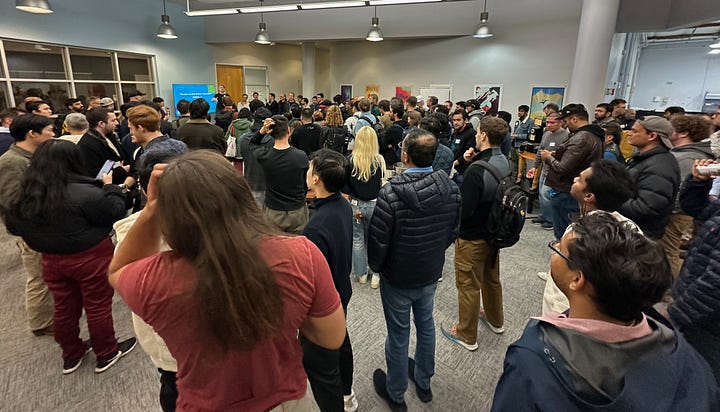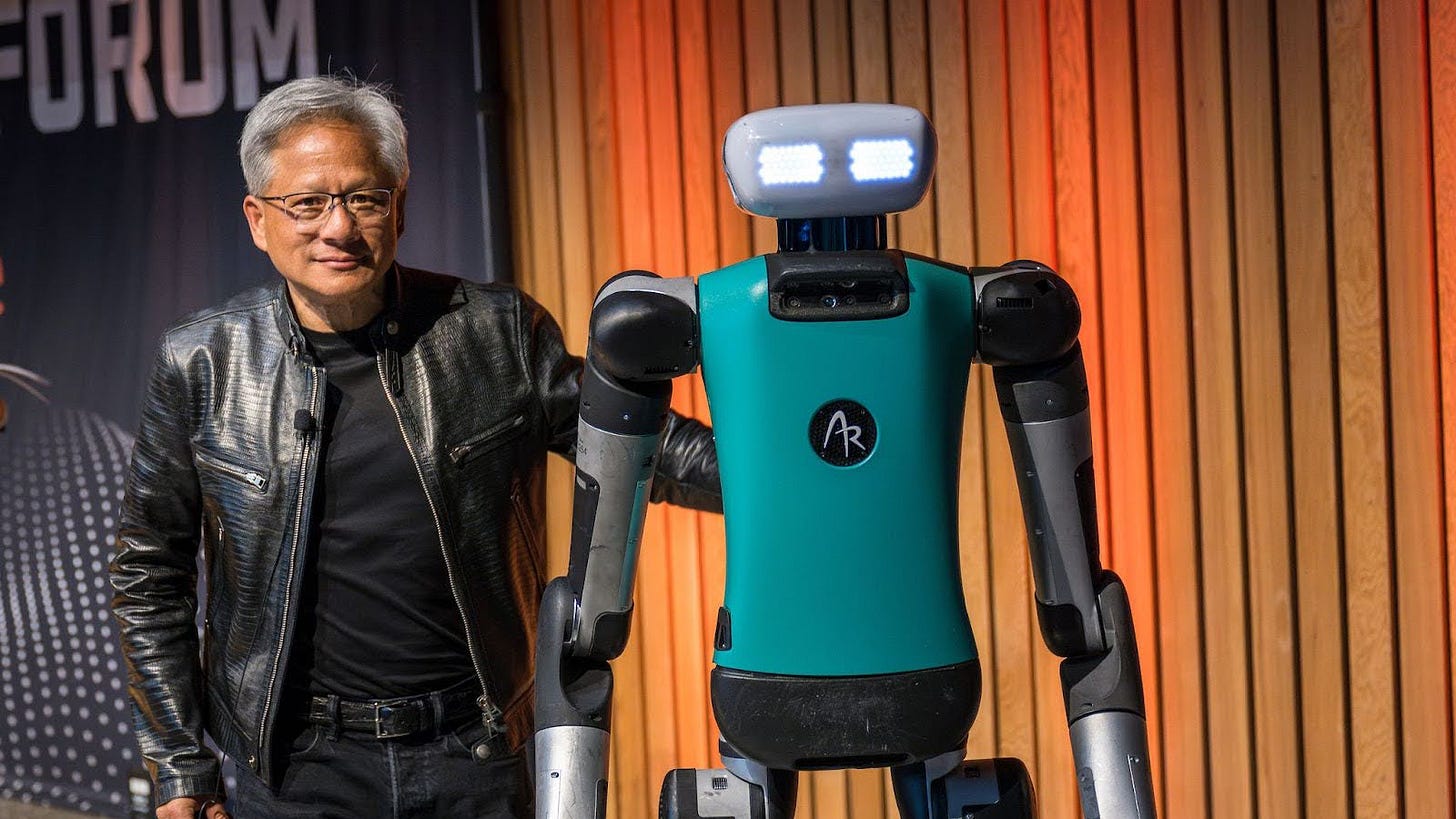Why the physics of humanoids works best
The first robots were really people not machines and Ray Dalio on redistributing the wealth from robotics and AI
The stability polygon and optimal design for doing human jobs in human workspaces leads to design choices in robots that emulate human form factor, as Pras Velagapudi from Agility Robotics explains in a recent podcast with Audrow Nash.
It just so happens that when you're dealing with things that are weights and payloads in human scale and around eyelets and things like that, that are again sized for humans, you start to up, you start to find that you're optimizing towards a human form factor. The legs end up being similar in size. In order to move human payloads, you need to be about human weight and human height.
Every other design choice increases the mass, inertia, energy requirements and mechanical complexity of a robot system without significantly increasing the benefits. Pras dives into exploring solutions like three arms, or wheels at the end of legs, or the use of a mobile wheeled base with robot arms, or even octopus type robots and more imaginative solutions and the tradeoffs in the inherent physics of performing human work all lead back to designing robots that are human-like.
Human-like robots may be unnecessary if you can build a complete automation from the start but the reality is that we live in a world with a huge sunk cost in human accessible infrastructure. Even if we consider humanoid robots as a transition period towards full automation, that’s a massive market opportunity for at least a generation.
There is section of the market that can be serviced by robot arms on a wheeled base, but that is constrained by the weight and size of the payload. While a wheeled base is more stable, that stability is contingent on the payload in play at the end of the arms. Compensating for that payload requires increasing the size and mass of the wheeled base, which in turn decreases the efficiency and economy.
Agility Robotics, in collaboration with other companies like Boston Dynamics, have been driving the development of new standards for dynamically stable robots like humanoids, as well as addressing how current AMR standards fall short of addressing the stability issues involved in adding arms to AMRs. So far the AMR industry has largely been solving for load carrying on a stable base, rather than moving materials on and off the base.
To be able to build functionally safe robots, human-like or armed AMRs, Pras describes the evolution of two levels of certainty. First is solving for stability in the job, between the robot, the payload and the environment. The second and more complex requirement is solving for added humans, something that Agility is aiming for with the next iteration of Digit.
So far, the humanoid or human-like robots that are deployed in real production environments (not innovation centers, research labs or other video friendly locations) have to be behind safety fences or segregated areas. As explained, companies taking the shortcut of putting manipulation on top of an AMR can still only perform tasks that maintain the inherent stability of the AMR system which means performing minimal payload movement.
Diligent Robotics is a great example of maximizing the value of this kind of robot. The payloads that Moxie moves around in hospitals are very small and light, but the value provided is high. Moxie can perform these tasks safely without having to address the increased dynamic stability demands that come up with greater payloads.
Enjoy the rest of the podcast, where Pras discusses tool changers at the end of Digit’s arms as the best solution for enhanced robot dexterity. the labor requirements of warehouse, logistics and manufacturing facilities, working with OSHA or equivalents, working with Gemini and where Agility uses reinforcement learning in the robotics stack, the Agility robot app store and the ability for the integrator or enduser of a robot to easily create and customize workflows.
Currently, there’s more commercial demand for Digit than Agility Robotics can meet so it’s exciting to hear about their latest round of investment from partners including Nvidia. In April, Agility announced a $400 million funding round at a $1.7 Billion valuation, and latest reports show that Agility has been deployed in nearly 20 major projects worldwide, bringing in around $400 million in revenue.
So for us, that 2 to 5 year timeline is really is a scaling timeline. It's get these last few pieces unlocked and then just open the floodgates. And so we hope that's that's what our next 2 to 5 years look like. We hope that we are going to be out there in the world that Digits will be doing, lots of different tasks, that they'll be easy to deploy, that they'll be out working full shifts, in the places that we can deploy them now from regulatory standpoint. And then that will basically be the, the, the driving function for other industries to want it. Right. They'll see them. And that'll become kind of a fire that that gets lit to say, hey, I want these in, in my stores, in my facilities, in my use cases. And that'll help really drive the, the ecosystem to, to scale further.
Where does the wealth from robotics and AI go?
Speaking on “The Diary Of A CEO” podcast, Dalio described a future where humanoid robots, smarter than humans, and advanced AI systems, powered by trillions of dollars in investment, could render many current professions obsolete.
Dalio sees a historical precedent for such transformative shifts. He likened the current era to previous evolutions, from the agricultural age, where people were treated “essentially like oxen,” to the industrial revolutions where machines replaced physical labor. He said he’s concerned about a similar thing with mental labor, as “our best thinking may be totally replaced.” Dalio highlighted that throughout history, “intelligence matters more than anything” as it attracts investment and drives power.
Sadly, Dalio also believes that human nature and our geopolitics will make it very difficult for constructive wealth redistribution policies to be implemented. And that more than just a transfer of wealth is needed. Humans need a sense of worth, or purpose, and usefulness.
Ray Dalio calls for wealth ‘redistribution policy’ when AI and humanoid robots start to benefit the 1% to 10% more than everyone else - Fortune
The word robot describes people not machines
In this edition of Word of the Week, we look at how "robot" went from referring to machine-like humans to human-like machines in the span of about 100 years.
"Most audiences understood the robots in the play to be a reference to human workers, and what would happen if they became self-conscious and overthrew their masters, as it was perceived had been done in the Russian Revolution," according to Tobias Higbie, a professor of history and labor studies at the University of California, Los Angeles.
A play about the revolt of human workers — not machines — gave us the word 'robot' - NPR
COMMUNITY NEWS
Foxglove's annual developer conference for physical AI, Actuate, is back next month. The two-day event will take place on September 23rd & 24th at the SFJAZZ in San Francisco, CA.
Acuate is one of the premier conferences for robotics developers looking to gain insight to tools, processes, and workflows used by leading companies to bring autonomous robotics to market.
As a partner of Foxglove, Silicon Valley Robotics has arranged a 15% discount code for registration.
15% registration discount code: SVROBO15
Register here
NEDO SV Foresight Seminars: Inventing the Future: Robotics Powered by AI
We’re pleased to invite you to an exclusive seminar on industrial robotics, where experts will share insights into this fast-evolving field.
Free at PlugnPlay on Sept 15. Speakers include:
Dhruv Diddi, Founder of https://www.getsolo.tech/
Bob Price Ph.D., Principal Research Engineer in Robotics at http://www.sri.com/ & PARC
Peter Lowe, CTO, https://www.withcargo.com/
Kenny Lee, co-Founder and CEO, https://www.aigen.io/
Yang Fang Ph.D.,Founder https://www.beagle-tech.com/
FIRA USA for AgRobotics
I'm excited to share a special invitation with you for this year's FIRA USA, taking place from October 21st - 23rd in Woodland, CA. This unique event focuses on autonomous solutions for specialty crops and large-scale farming, making it a must-attend for anyone in the agricultural robotics market.
As a partner of FIRA USA, Silicon Valley Robotics is proud to support this incredible event, and we hope you will join us. We've arranged a special 20% discount code for registration. Feel free to use this code as many times as you need.
20% registration discount code: NAOMISHISAIKEGUESTS
Register here
This year, Reservoir Farms will be exhibiting and will also be a stop on the "CA Ag Robotics Tour" hosted by FIRA USA. It's a fantastic opportunity to see the latest innovations in action on various farms.
Silicon Valley Robotics Investor/Startup Database
Are you a startup fundraising atm? Fill out our "For Investors Eyes Only" sheet.
These investors write checks anywhere from angel and seed stage to $5-50 million.
Feedback from the startups - high quality inbound interest from investors.
Feedback from the investors - incredible depth and range of robotics startups.
If you’re an accredited investor and haven’t already signed up for the spreadsheet - Sign up here for great robotics deal flow!
Robotics News
We are entering a golden age of robotics startups — and not just because of AI - TechCrunch
Nvidia backs Agility Robotics, with Taiwan suppliers set to ride the humanoid wave - DigiTimes
Andromeda raises $23m Series A for humanoid companion robot - Capital Brief
China experiences physical AI surge — and how the U.S. should respond - The Robot Report
Fourier GR-3 Humanoid Robot Wants to be More Than a Machine with Its Cushioned Surfaces - TechEBlog
Could AI nursing robots help health care staffing shortages? - CNN
Rendezvous Robotics exits stealth with $3M to build reconfigurable space infrastructure - TechCrunch
CAL FIRE and Sikorsky partner on autonomous helicopter development - AirMed&Rescue
Is NATO prepared for autonomous warfare - National Interest
Reality is ruining the humanoid robot hype - IEEE Spectrum
Humanoid robots move from labs to production lines in factories and warehouses - Interesting Engineering
Australia to spend $1.1 billion on Anduril undersea drone fleet - Reuters
Amazon's Zoox launches its autonomous robotaxi service - Engadget
WeRide expands into Belgium with autonomous robobus service - JustAuto
Alibaba's Ant Group Unveils First Humanoid Robot In China - Yahoo Finance
Japan Is Starting to Use Robots in 7-Eleven Shops to Compensate for the Massive Shortage of Workers - ZME Science
Kodiak Robotics delivers its first factory-made autonomous truck - FreightWaves
RoboSense integrates LiDAR portfolio with NVIDIA DRIVE to accelerate autonomous driving adoption - GasGoo
Robotics Startup Physical Intelligence in Talks to Raise at $5 Billion Valuation - The Information
Robotics Events
Actuate - Sep 23-24 (use our code “SVROBO15” for 15% discount)
SVR Robotics Investment Summit - Sep 25 (invite only)
FIRA USA, Woodland CA - Oct 21-23 (use our code “NAOMISHISAIKEGUESTS” for 20% discount)
ROSCON Singapore - Oct 27-30
SVR Robotics Leadership Summit - Dec 10
Humanoids Summit - Dec 11-12
Join the organizing team at Silicon Valley Robotics - bots&beer@svrobo.org




